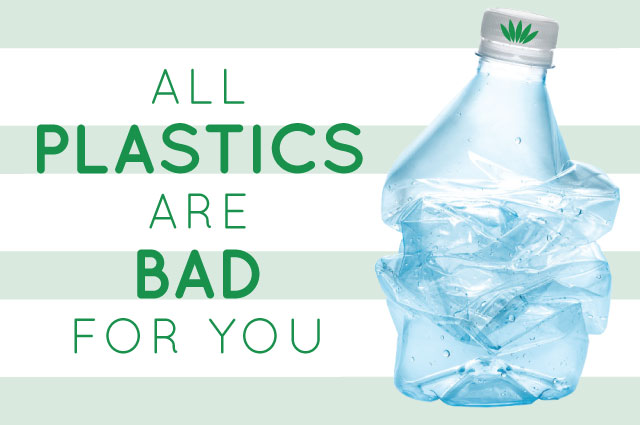A study published in the journal Environmental Health Perspectives concludes that there really are no “safe” plastics, thanks to all the chemicals, additives, and processing aids that go into making plastic products.
For individuals that want to toss the plastic habit, you would think they could at least rely on certain types of plastics, ones labeled #2, #4, or #5, because those plastics aren’t made using bisphenol A or phthalates. In a test of nearly 500 chemical containers, the authors discovered that nearly all exhibited some kind of estrogenic activity.
The Latest Study on Plastics
The authors purchased 455 plastic products designed to hold food (including plastic bags and baby bottles) that were made from all different types of plastic. Some of the plastics tested, such as high-density polyethylene (#2 in the recycling triangle) and polypropylene (#5 in the recycling triangle), are considered safer plastics because, prior to this study, they hadn’t been shown to leach chemicals. Some of the other plastics, such as corn-based plastics and newer so-called “BPA-free” plastic resins, were also tested. All the plastics were filled with substances mimicking food and then subjected to three types of stress—microwave heating, moist heat similar to what they might be exposed to in a dishwasher, and UV light (simulating a water bottle left in a car during the day or a baby bottle being subjected to UV sterilization).
The researchers were able to measure some type of estrogenic chemical leaching from roughly 95 percent of all the plastics tested, including 100 percent of the food wraps and 98 percent of the plastic bags. Even when the plastics were unstressed and just exposed to various solutions, they still leached estrogenic chemicals. And some of the baby and water bottles labeled “BPA free” showed greater estrogenic activity than polycarbonate bottles, which are made from BPA. When they were subjected to stress, the amount of leaching largely depended on what was in the packaging. For instance, some of the highest levels of leaching occurred in plastics containing saline solution when they were put in the microwave; saline is intended to mimic vegetables or other foods with a high water content. But baby bottles containing ethanol, which is intended to mimic milk and other foods with a higher fat content, leached more when exposed to UV light than they did when they contained a saline solution.
There are No Safe Plastics
There really aren’t any “safer” plastics, and it’s hard to predict which ones will leach estrogenic chemicals into your food. As this study shows, different plastics containing different types of foods will leach chemicals at different levels. That’s largely because there are so many steps and additives in the plastic-making process, says George Bittner, PhD, professor of biology at the University of Texas in Austin and lead author of the study. “A plastic item can subsist of anywhere from five to 20 chemicals, some of which are additives, which are incorporated within the plastic polymer but not bound to the structure,” he says. Both the materials that make up the plastic resin and the additives can leach out of plastics, says Bittner, who’s also the CEO of CertiChem, the lab that tested the plastics in this study, and a consultant for PlastiPure, a company that works with plastic manufacturers to produce estrogenic-chemical-free plastics. You also have mold-release agents and colorants that are used to make or decorate the plastics, adds Mike Usey, CEO of PlastiPure, and those colorants tend to be highly estrogenic.
“We’re not testing in a way that the industry has traditionally done this,” Usey says. “We’re not identifying specific chemicals, finding those, and then substituting another chemical. We’re looking at the entire product.” And that’s where the industry has largely failed at keeping estrogenic chemicals out of products. He uses the example of baby bottles, which were once commonly made with BPA-based polycarbonate plastics. After parents started to demand BPA-free bottles, the industry switched to two primary alternatives, PETG and PES—hard, clear plastics that do not contain BPA. However, “we’ve done quite a few tests, and the level of estrogenic activity that we have found under certain conditions, especially under UV light, has been higher than with polycarbonate,” Usey says. And, he adds, it’s hard to pinpoint the source of the estrogenic activity without knowing the exact makeup of the plastic and any processing aids, additives, or colorants used in the final product. “Since the health effects [of estrogenic chemicals] occur at such a low level, it doesn’t take much for something to be highly estrogenic,” he adds.
Usey and Bittner don’t think people should eliminate plastics from their lives entirely. “I think plastics are great—they just need to be made safer,” Usey says. Bittner adds, “Consumers should request from the stores where they buy plastics that those stores start supplying them with plastics that are free of estrogenic activity.”
Live a Plastic-Free Life
• Revamp your food storage. Glass, ceramic, and stainless steel are great food storage materials that can go from stove to fridge to freezer easily.
• Buy less processed food. Most processed foods in the grocery store come in some form of plastic packaging. Buying fresh vegetables and ingredients in bulk (which you can package in your own plastic-free containers) will help you avoid most of it.
• BYO… You may already carry a reusable mug and reusable shopping bags to eliminate some plastics, but take the next step and start carrying reusable produce bags, too, when you shop. Like other forms of plastic, those flimsy plastic produce bags can leach hormone-disrupting chemicals into your berries and broccoli, and they’re hard to recycle once they’re contaminated with food. You can find regular and organic cotton produce bags online at Ecobags.com.










